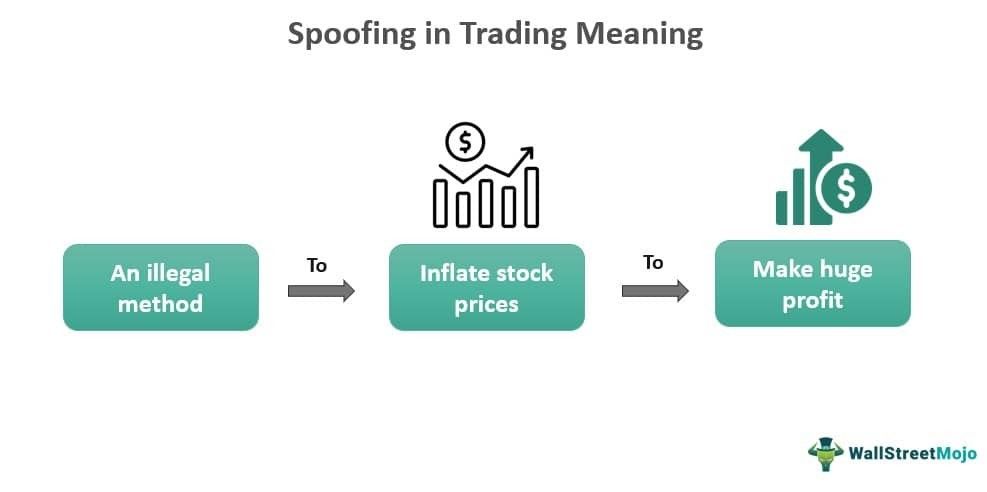Table of Contents
What Is Spoofing In Trading?
Spoofing in trading means the illegal method of inflating a company's stock prices through false selling and buying orders and then canceling before the order gets fulfilled to make huge profits. Traders have used the technique to gain undue advantages over others to increase the asset price and profit from duping investors.

Here, traders conduct deceptive orders to trick the remaining securities markets into believing there is a higher demand for sell or buy orders than in reality. Spoofers make profits by forcing the markets to go up or down in small increments. It allows spoofers to buy at a low price and sell when the prices go up. The process gets repeated innumerable times within a few minutes, which finally adds up to significant profits.
Key Takeaways
- Spoofing in trading can be defined as the illegal practice by traders with the intention to dupe investors by undertaking fake orders that are meant to be never executed for high gains.
- It basically gets carried out by spoofers to fool investors into buying or selling their securities in holding by manipulating the price of securities using bots to gain good revenue.
- It can be detected by using the NASDAQ-created surveillance system SMARTS.
- The best way to stop spoofing is to be objective while investing in shares and not let emotions or social media influence the decision to trade to gain profits.
Spoofing In Trading Explained
Spoofing in trading refers to spamming the securities market with fake buy or sell orders by traders so as to raise the price of securities artificially and then cancel all these orders when the prices reach the peak to sell for exorbitant prices, leading to huge profits as one knows that prices of security in the market get determined by the law of supply and demand. It means that high-demand security will have a high price and vice versa. In natural course, it takes too much time for the price of a particular security to increase and decrease only when many investors feel that the company will make huge profits or losses.
However, some traders want to get immediate profit from manipulating the securities price they have in their account, which is called spoofing. For that to happen, they use bots or algorithms to artificially inflate the security prices and then sell at the peak point. These bots or algorithms are designed to place huge buy or sell orders for specific securities during trading. As a result, the number of security trades increases proportionately, leading to highly inflated prices or low prices.
At a point when the manipulative trader finds that the artificial price inflation has reached the desired profit level, the bot then sells or buys these securities at handsome profits. Moreover, since spoofing involves a high volume of selling or buying securities using an algorithm, it tends to be called high-frequency trading. Spoofing in trading is illegal and a criminal offense, whether it relates to spoofing in crypto, stocks, or forex, as per the 2010 Dodd-Frank Act.
Many traders use Saxo Bank International to research and invest in stocks across different markets. Its features like SAXO Stocks offer access to a wide range of global equities for investors.
How To Detect?
To protect oneself from spoofing activities, one must take note of the following:
- One must carefully analyze the streaming of stock data of the market.
- The placement of bulk trading orders of stocks taking place.
- Peculiar quoted stock price movement.
- Higher ratios of cancellation of orders.
- A series of high volume of order cancellations follows.
- One can use trade surveillance technology to spot spoofing developed by NASDAQ called Nasdaq Trade Surveillance.
How To Stop?
One has to be highly careful to stop oneself from getting caught in the action of spoofing:
- One must create an investing strategy.
- One must not go by one's emotions when investing in markets.
- One must refrain from believing in social media trends regarding stock markets.
- Investors must objectively determine the real driver of security prices in the market.
Examples
Let’s use some examples to understand the concept of the topic.
Example #1
Let us suppose Noah, a trader, has 50000 shares of company XYZ securities that he wants to sell. Noah uses a special algorithm that can place thousands of buy orders for the stocks of firm XYZ but can cancel all these orders just before they get executed without spending the actual amount on the orders.
These fake or spoofed buy orders increase the share prices of the firm XYZ stocks to double the original value. As a result, Noah sells all their shares, 100,000 in number, at this inflated price. Thus, Noah manipulated the market price of the shares of firm XYZ and obtained huge profits from spoofing in trading.
Example #2
In 2020, another spoofing in trading related to U.S. Treasury securities took place in the United States. This time, JPMorgan Chase got caught spoofing in the precious metal trade in the market. As a result, it was fined almost one billion dollars by the U.S. Securities And Exchange Commission (SEC ). Later, the U.S. Commodity Futures Trading Commission (CFTC) & the U.S. Department of Justice found their involvement in illegal spoofing activity related to sharing manipulation in 2015-16. Moreover, a fine of $10 million as disgorgement, plus $25 million as the penalty, was awarded to J.P. Morgan Securities by the SEC and $920 million as a fine by the U.S. Commodity Futures Trading Commission (CFTC) & the U.S. Department of Justice.
Disclosure: This article contains affiliate links. If you sign up through these links, we may earn a small commission at no extra cost to you.

